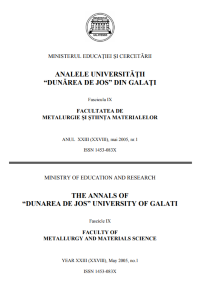The Properties of Hardened Lead
Abstract
Lead hardened through oxide scattering is investigated as raw materials for the fabrication of the support gratings of lead accumulators in order to increase their life service. For the preparation of lead powder hardened through oxide cattering we used air jet pulverisation, a technique specific to powder metallurgy. Two research approaches are presented in the paper: one in which the oxide was introduced through oxidised lead powder, and the other in which additional lead oxide was introduced. Oxide dispersion into metallic matrix was achieved by pronounced deformation through extrusion of the powder. During extrusion, the particles are compelled to pass through the mould calibration zone and consequently they are considerably deformed. As an effect of this deformation, the particles of fragile oxide which cover the lead powder particles are crashed and carried away to the material flowing through the matrix longitudinally on the extruded semi-product. The content of oxide introduced in matrix by the oxidised lead powder depends on the powder particle size. This paper presents the effect of the powder particle size and oxide phase dispersion in the metallic matrix on the mechanical, chemical and electrical properties of the extruded semi-products. The semi-products made from lead powder belonging to the grain size class of < 40 μm and oxide particles allowance have the highest mechanical resistance and the best corrosion behaviour. Using controlled oxidised lead powder better extruded semiproducts are obtained in terms of mechanical resistance, corrosion behaviour and electrical conductivity as compared with lead and Pb-Sb alloy. A higher electrical conductivity represents an important advantage especially for the starting accumulators where the voltage fall should be as low as possible.
Downloads
References
[2]. F. L. Matthews and R.D.R. Rawhings: Composite Materials: Engineering and Science, (Published by Chapman and Hall, London SE18HN, Oxford ISBN 0412559609(HB), 1994).
[3]. O. Potecasu, F. Potecasu, E. Drugescu, P. Alexandru: Proceedings of the European Conference Junior - Euromat, 26-30, Aug. 1996 (Deutsche Gesellschaft für Materialkunde e.V., Lausanne, Switzerland 1996), p. 156.
[4]. F. Potecasu, O. Potecasu, E. Drugescu, P. Alexandru: Proceeding of the 40th International Seminar on Modelling and Optimisation of Composites MOC'40, Odessa, April 2001 (IAE - International Academy of Engineering, ISBN 966-549-565-8, Odessa, Ukraine 2001), p. 172.
[5]. O. Potecaşu, F. Potecaşu, E. Drugescu, P. Alexandru: Proceedings of The Fourth International Congress Science and Engineering, Universitatea Tehnică “Gheorghe Asachi”, Jassy 2002 (Bulletin of the Polytechnic Institute of Jassy 18-20 April 2002, volume XLVIII-LII, Nr. 3-4, The Technical University, ISSN 1453-1690, Jassy, Romania), p. 9.



